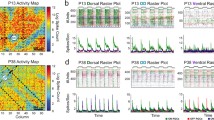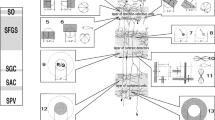Summary
The retinotectal projection of the goldfish was studied after regeneration of a cut optic nerve in stroboscopic light, constant light or diurnal light, with the lens removed to blur the retinal image. Retrograde transport of wheatgerm agglutinin, conjugated to horseradish peroxidase, from a standard tectal injection site was used to measure the topographic precision of the projection. The dispersion of labelled retinal ganglion cells, which reflects this precision, was assessed by a method based on distance to nearest neighbour. In normal fish treated similarly, these cells are known to be clustered into about 1% of the retinal area. Early in regeneration, however, they are widely dispersed. The projection map then re-acquires its precision over two or three months.
In diurnal light, lens ablation had no effect on refinement of the regenerated map. Constant light increased the number of labelled cells but also had no significant effect on the map. But in stroboscopic light with a continuous pseudorandom pattern of flash intervals (average rate 4.8 Hz), much less refinement was seen. Even after 70–98 days of regeneration, labelled cells remained scattered, on average, over 20% of the retinal area. These retinae were indistinguishable by several criteria from those obtained in diurnal light after only 32–39 days. Mislocated axon terminals, which are largely eliminated during the second and third months of regeneration in diurnal light, evidently persist much longer in stroboscopic light that synchronizes ganglion cell activity across the retina. These results, like previous ones obtained by blocking the transmission of activity to the tectum, support a model of map refinement based on correlation in the firing of neighbouring neurons, which may have wide application within the nervous system.
Similar content being viewed by others
References
Archer SM, Dubin MW, Stark LA (1982) Abnormal development of kitten retino-geniculate connectivity in the absence of action potentials. Science 217: 743–745
Arnett DW (1978) Statistical dependence between neighboring retinal ganglion cells in goldfish. Exp Brain Res 32: 49–53
Bunt SM (1982) Retinotopic and temporal organization of the optic nerve and tracts in the adult goldfish. J Comp Neurol 206: 209–226
Burmeister DW, Perry GW, Grafstein B (1983) Target regulation of the cell body reaction during regeneration of goldfish retinal ganglion cells. Soc Neurosci Abstr 9: 694
Chalupa LM, Rhoades RW (1978) Modification of visual response properties in the superior colliculus of the golden hamster following stroboscopic rearing. J Physiol (Lond) 274: 571–592
Chung SH, Gaze RM, Stirling RV (1973) Abnormal visual function in Xenopus following stroboscopic illumination. Nature New Biol 246: 186–188
Clark PJ, Evans FC (1954) Distance to nearest neighbour as a measure of spatial relationships in populations. Ecology 35: 445–453
Cook JE (1983) Tectal paths of regenerated optic axons in the goldfish: evidence from retrograde labelling with horseradish peroxidase. Exp Brain Res 51: 433–442
Cook JE (1984) A simple pseudorandom interval generator. J Physiol (Lond) 357: 6P
Cook JE (1986) A sharp retinal image increases the precision of the regenerated goldfish retinotectal projection under stroboscopic conditions. J Physiol (Lond) 372: 84P
Cook JE, Horder TJ (1977) The multiple factors determining retinotopic order in the growth of optic fibres into the optic tectum. Philos Trans R Soc (Lond) B 278: 261–276
Cook JE, Rankin ECC (1984a) Use of a lectin-peroxidase conjugate (WGA-HRP) to assess the retinotopic precision of goldfish optic terminals. Neurosci Lett 48: 61–66
Cook JE, Rankin ECC (1984b) An effect of stroboscopic light on the retinotopography of regenerated optic terminals in goldfish. J Physiol (Lond) 357: 23P
Easter SS Jr, Rusoff AC, Kish PE (1981) The growth and organization of the optic nerve and tract in juvenile and adult goldfish. J Neurosci 1: 793–811
Edwards DL, Grafstein B (1983) Intraocular tetrodotoxin in goldfish hinders optic nerve regeneration. Brain Res 269: 1–14
Edwards DL, Grafstein B (1984) Intraocular injection of tetrodotoxin in goldfish decreases fast axonal transport of 3H-glucosamine-labeled materials in optic axons. Brain Res 299: 190–194
Ginsburg KS, Johnsen JA, Levine MW (1984) Common noise in the firing of neighbouring ganglion cells in goldfish retina. J Physiol (Lond) 351: 433–450
Johns PR (1977) Growth of the adult goldfish eye. III. Source of the new retinal cells. J Comp Neurol 176: 343–358
Marotte LR, Wye-Dvorak J, Mark RF (1979) Retinotectal reorganization in goldfish — II. Effects of partial tectal ablation and constant light on the retina. Neuroscience 4: 803–810
Mastronarde DN (1983) Correlated firing of cat retinal ganglion cells. I. Spontaneously active inputs to X- and Y-cells. J Neurophysiol 49: 303–324
McLoon SC (1982) Alterations in precision of the crossed retinotectal projection during chick development. Science 215: 1418–1420
Meyer RL (1982) Ordering of retinotectal connections: a multivariate operational analysis. In: Moscona AA, Monroy A (eds) Neural specificity, plasticity, and patterns. Curr Top Dev Biol 17. Academic Press, New York, pp 101–145
Meyer RL (1983) Tetrodotoxin inhibits the formation of refined retinotopography in goldfish. Dev Brain Res 6: 293–298
Murray M, Sharma SC, Edwards MA (1982) Target regulation of synaptic number in the compressed retinotectal projection of goldfish. J Comp Neurol 209: 374–385
O'Leary DDM, Fawcett JW, Cowan WM (1984) Elimination of topographical targeting errors in the retinocollicular projection by ganglion cell death. Soc Neurosci Abstr 10: 464
Olson CR, Pettigrew JD (1974) Single units in visual cortex of kittens reared in stroboscopic illumination. Brain Res 70: 189–204
Pearson HE, Murphy EH (1983) Effects of stroboscopic rearing on the response properties and laminar distribution of single units in the rabbit superior colliculus. Dev Brain Res 9: 241–250
Rankin ECC, Cook JE (1986) Topographic refinement of the regenerating retinotectal projection of the goldfish in standard laboratory conditions: a quantitative WGA-HRP study. Exp Brain Res 63: 409–420
Rodieck RW (1967) Maintained activity of cat retinal ganglion cells. J Neurophysiol 30: 1043–1071
Schmidt JT (1985a) Apparent movement of optic terminals out of a local postsynaptically blocked region in goldfish optic tectum. J Neurophysiol 53: 237–251
Schmidt JT (1985b) Formation of retinotopic connections: selective stabilization by an activity-dependent mechanism. Cell Mol Neurobiol 5: 65–84
Schmidt JT, Edwards DL (1983) Activity sharpens the map during the regeneration of the retinotectal projection in goldfish. Brain Res 269: 29–39
Schmidt JT, Eisele LE (1985) Stroboscopic illumination and dark-rearing block the sharpening of the regenerated retinotectal map in goldfish. Neuroscience 14: 535–546
Schmidt JT, Edwards DL, Stuermer C (1983) The re-establishment of synaptic transmission by regenerating optic axons in goldfish: time course and effects of blocking activity by intraocular injection of tetrodotoxin. Brain Res 269: 15–27
Schneider GE, Jhaveri S (1984) Rapid postnatal establishment of topography in the hamster retinotectal projection. Soc Neurosci Abstr 10: 467
Siegel S (1956) Nonparametric statistics for the behavioral sciences. McGraw-Hill Tokyo, pp 184–194
Stuermer CAO, Easter SS Jr (1984) A comparison of the normal and regenerated retinotectal pathways of goldfish. J Comp Neurol 223: 57–76
Whitelaw VA, Cowan JD (1981) Specificity and plasticity of retinotectal connections — a computational model. J Neurosci 1: 1369–1387
Willshaw DJ, Malsburg C von der (1976) How patterned neural connections can be set up by self-organization. Proc R Soc (Lond) B 194: 431–445
Author information
Authors and Affiliations
Rights and permissions
About this article
Cite this article
Cook, J.E., Rankin, E.C.C. Impaired refinement of the regenerated retinotectal projection of the goldfish in stroboscopic light: a quantitative WGA-HRP study. Exp Brain Res 63, 421–430 (1986). https://doi.org/10.1007/BF00236861
Received:
Accepted:
Issue Date:
DOI: https://doi.org/10.1007/BF00236861




